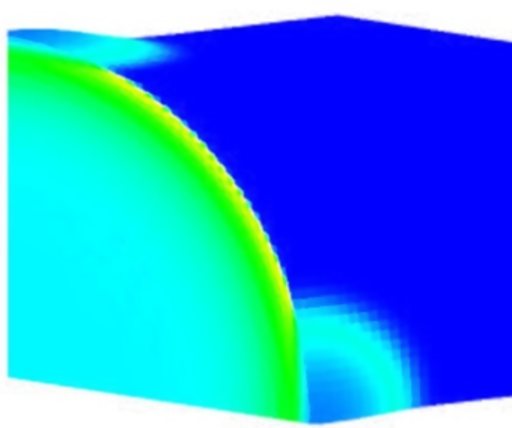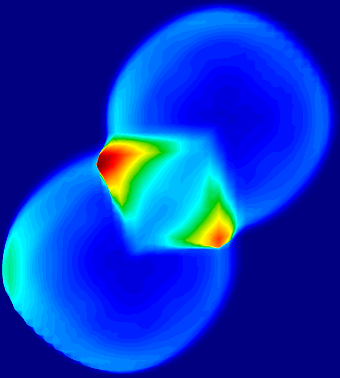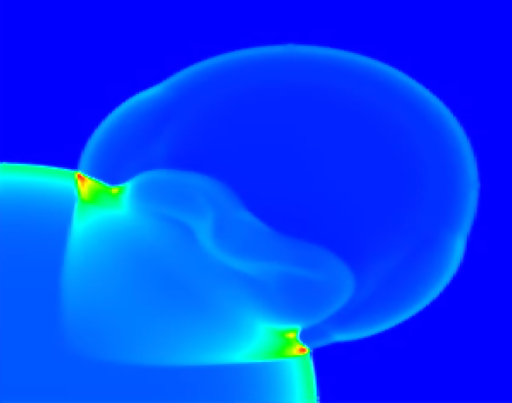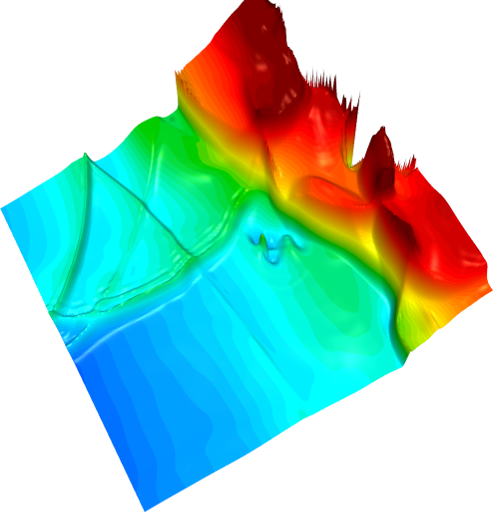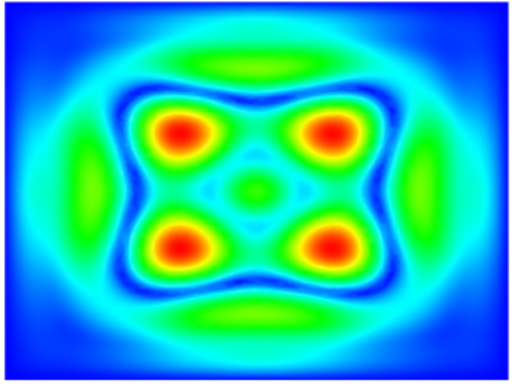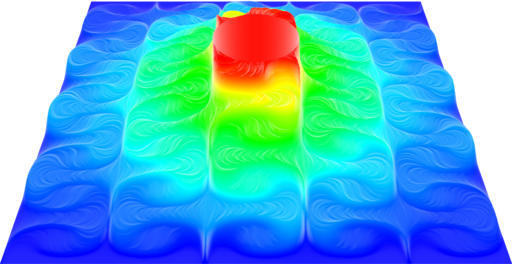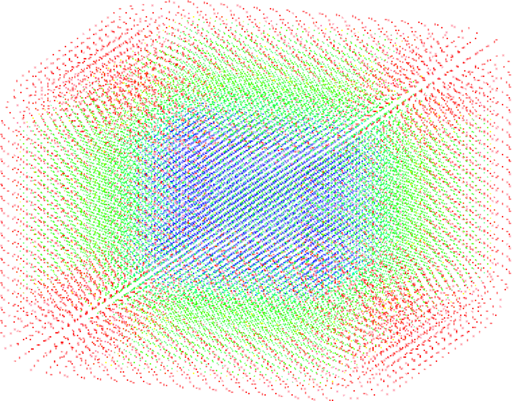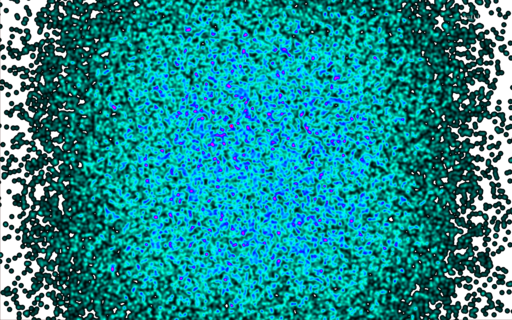∇-Nabla: Numerical Analysis BAsed LAnguage
∇ Port of the LULESH proxy application
This code can be found in the test/lulesh directory.
The two files lulesh.n and luleshGeom.n are commented here.
Most of the job and function comments have been copied from the technical report:
Hydrodynamics Challenge Problem Lawrence Livermore National Laboratory-LLNL-TR-490254.
∇ Lulesh Porting Tutorial
Most of the work when porting code to ∇ is to determinate:
- options that you would like to play with within your simulations
- mesh variables that are used: node, cell, face or particle variables
Once you have your variables and options, you are ready to isolate each for-loop of the code in order to turn them into ∇ job ones. Looking for them is easy, isolating each of them, putting the right in, inout and out represent the tedious part (a tool could probably help us to fill in these declarations).
While looking for each of these jobs, you should have a good idea of
their sequence: it is time to tag each of them with a logical-time
attribute with the @ statements.
For now, most of the proxies applications do not require specific
parallel @ statements: the jobs are quite triggered
sequentially. It is less the case when you begin a new project and
start using this possibility to launch different parallel jobs
(like the Monotone Non-Linear DDFV example).
By convention, initialization phase takes place from ]-∞,-0.0[ and the top level compute loop within ]0.0,+∞[.
Standard functions can be gathered in an other file: they will be presented like all the project files to the compiler that will make the overall synthesis.
Mesh Variables Definitions
with cartesian; // **************************************************************************** // * Options // **************************************************************************** options{ ℝ option_dtfixed = -1.0e-7; // fixed time increment ℝ option_δt_initial = 1.0e-7; // variable time increment ℝ option_δt_courant = 1.0e+20; ℝ option_δt_hydro = 1.0e+20; ℝ option_δt_mult_lower_b = 1.1; ℝ option_δt_mult_upper_b = 1.2; ℝ option_initial_energy = 3.948746e+7; ℝ option_stoptime = 1.0e-2; // end time for simulation ℝ option_hgcoef = 3.0; // hourglass control ℝ option_qstop = 1.0e+12; // excessive q indicator ℝ option_monoq_max_slope = 1.0; ℝ option_monoq_limiter_mult = 2.0; ℝ option_e_cut = 1.0e-7; // energy tolerance ℝ option_p_cut = 1.0e-7; // pressure tolerance ℝ option_q_cut = 1.0e-7; // q tolerance ℝ option_u_cut = 1.0e-7; // node velocity cut-off value ℝ option_v_cut = 1.0e-10; // relative volume tolerance ℝ option_qlc_monoq = 0.5; // linear term coef for q ℝ option_qqc_monoq = 0.6666666666667;//666666; // quadratic term coef for q ℝ option_qqc = 2.0; ℝ option_eosvmax = 1.0e+9; ℝ option_eosvmin = 1.0e-9; ℝ option_pmin = 0.0; // pressure floor ℝ option_emin = -1.0e+15; // energy floor ℝ option_dvovmax = 0.1; // maximum allowable volume change ℝ option_refdens = 1.0; // reference density ℝ option_dtmax = 1.0e-2; // maximum allowable time increment ℾ option_chaos = false; ℝ option_chaos_seed = 1.1234567890123;//456789; ℕ option_max_iterations = 32768; }; // **************************************************************************** // * Node Variables // **************************************************************************** nodes{ ℝ³ 𝜕x; // Velocity vector ℝ³ 𝜕𝜕x; // Acceleration vector ℝ³ nForce; // Force vector ℝ nodalMass; // Nodal mass }; // **************************************************************************** // * Element Variables // **************************************************************************** cells{ ℝ p,e,q; // pressure,internal energy, artificial viscosity, relative volume ℝ v,calc_volume,vdov; // instant and relative volume ℝ delv,volo; // relative volume change, reference (initial) volume ℝ arealg; // characteristic length ℝ³ ε; // diagonal terms of deviatoric strain dxx(),dyy(),dzz() ℝ ql,qq; // artificial viscosity linear and quadratic term ℝ³ cForce[nodes]; ℝ delv_xi, delv_eta, delv_zeta; // velocity gradient ℝ delx_xi, delx_eta, delx_zeta; // coordinate gradient ℝ phixi, phieta, phizeta; ℝ vnew, elemMass; ℝ e_old,p_old,q_old, delvc; ℝ compression, compHalfStep; ℝ work, p_new,e_new,q_new; ℝ bvc,pbvc, vnewc; ℝ pHalfStep, sound_speed; ℕ elemBC; ℝ δt_cell_hydro; ℝ δt_cell_courant; }; // **************************************************************************** // * Global Variables // **************************************************************************** global{ ℝ δt_courant; // Courant time constraint ℝ δt_hydro; // Hydro time constraint };
Initialization part ]-∞ ⇒ -0.0[
ini @ -10.0{ δt=(option_chaos)?option_δt_initial*option_chaos_seed:0.0; δt_hydro=option_δt_hydro; δt_courant=option_δt_courant; } ∀ nodes @ -12.0 { coord *= (option_chaos)?option_chaos_seed:1.0; } // **************************************************************************** // * Set up boundary condition information // * Set up elemement connectivity information // **************************************************************************** ∀ cells @ -9.5{ const ℝ zero = 0.0; const ℝ maxBoundaryX = LENGTH; const ℝ maxBoundaryY = LENGTH; const ℝ maxBoundaryZ = LENGTH; elemBC=0; ∀ node{ elemBC |= (coord.x==zero)?XI_M_SYMM; elemBC |= (coord.y==zero)?ETA_M_SYMM; elemBC |= (coord.z==zero)?ZETA_M_SYMM; elemBC |= (coord.x==maxBoundaryX)?XI_P_FREE; elemBC |= (coord.y==maxBoundaryY)?ETA_P_FREE; elemBC |= (coord.z==maxBoundaryZ)?ZETA_P_FREE; } } // **************************************************************************** // * Cells initialization // **************************************************************************** ∀ cells @ -8.0{ ℝ³ X[8]; const ℝ chaos = (((ℝ)uid)+1.0)*option_chaos_seed; v=1.0; ∀ node X[n]=coord; e=(option_chaos)?chaos:(uid==0)?option_initial_energy:0.0; sound_speed=p=q=(option_chaos)?chaos; volo=elemMass=calc_volume=computeElemVolume(X); } ∀ nodes @ -6.9{ nodalMass=0.0; ∀ cell nodalMass+=calc_volume/8.0; }
LULESH Compute Loop [0.0 ⇒ +4.0]
// **************************************************************************** // * timeIncrement // * This routine computes the time increment δtn for the // * current timestep loop iteration. We aim for a "target" value of t_final-tn // * for δtn . However, the actual time increment is allowed to grow by a // * certain prescribed amount from the value used in the previous step and is // * subject to the constraints δt_Courant and δt_hydro described in Section 1.5.3. // **************************************************************************** void timeIncrement(void) @ 0.1 { const ℝ target_δt = option_stoptime - time; const ℝ max_δt = 1.0e+20; const ℝ new_δt_courant = (δt_courant < max_δt)?½*δt_courant:max_δt; const ℝ new_δt_courant_hydro = (δt_hydro < new_δt_courant)?δt_hydro*2.0/3.0:new_δt_courant; const ℝ now_δt = new_δt_courant_hydro ; const ℝ old_δt = (iteration==1)?option_δt_initial:δt; const ℝ ratio = now_δt / old_δt ; const ℝ up_new_δt = (ratio >= 1.0)?(ratio < option_δt_mult_lower_b)?old_δt:now_δt:now_δt; const ℝ dw_new_δt = (ratio >= 1.0)?(ratio > option_δt_mult_upper_b)?old_δt*option_δt_mult_upper_b:up_new_δt:up_new_δt; const ℝ new_δt = (dw_new_δt > option_dtmax)?option_dtmax:dw_new_δt; const ℝ δτ = (option_dtfixed <= 0.0)?(iteration != 1)?new_δt:old_δt:old_δt; const ℝ scaled_target_δt = (target_δt>δτ)?((target_δt<(4.0*δτ/3.0))?2.0*δτ/3.0:target_δt):target_δt; const ℝ scaled_δt = (scaled_target_δt < δτ)?scaled_target_δt:δτ; δt = scaled_δt ; if (iteration >= option_max_iterations) exit; } // **************************************************************************** // * Sum contributions to total stress tensor // * pull in the stresses appropriate to the hydro integration // * Initialize stress terms for each element. Recall that our assumption of // * an inviscid isotropic stress tensor implies that the three principal // * stress components are equal, and the shear stresses are zero. // * Thus, we initialize the diagonal terms of the stress tensor to // * -(p + q) in each element. // **************************************************************************** ∀ cells @ 0.3 { const ℝ chaos = (((ℝ)0.0)+1.0)*option_chaos_seed; const ℝ sig = (option_chaos)?chaos:-p-q; ℝ³ fNormals,dj,x[8],B[8]; ∀ node x[n] = coord; ε = dj = -¼*((x[0]+x[1]+x[5]+x[4])-(x[3]+x[2]+x[6]+x[7])); calcElemShapeFunctionDerivatives(x,B); ∀ node B[n]=0.0; Σ_FaceNormal(B,0,1,2,3,x); Σ_FaceNormal(B,0,4,5,1,x); Σ_FaceNormal(B,1,5,6,2,x); Σ_FaceNormal(B,2,6,7,3,x); Σ_FaceNormal(B,3,7,4,0,x); Σ_FaceNormal(B,4,7,6,5,x); ∀ node cForce = -sig*B[n]; } ∀ nodes @ 0.301 { ℝ³ Σ=0.0; ∀ cell Σ+=cForce; nForce=Σ; } // **************************************************************************** // * calcFBHourglassForceForElems // * Calculates the Flanagan-Belytschko anti-hourglass force // * calcFBHourglassForceForElems // **************************************************************************** ∀ cells @ 1.3{ const ℝ γ[4][8]={{ 1., 1.,-1.,-1.,-1.,-1., 1., 1.}, { 1.,-1.,-1., 1.,-1., 1., 1.,-1.}, { 1.,-1., 1.,-1., 1.,-1., 1.,-1.}, {-1., 1.,-1., 1., 1.,-1., 1.,-1.}}; ℝ η0[4],η1[4],η2[4],η3[4] ; ℝ η4[4],η5[4],η6[4],η7[4]; ℝ³ x[8],xd[8],dvd[8],η[8]; const ℝ hourg=option_hgcoef; const ℝ τv = volo*v; const ℝ volume13=∛(τv); const ℝ θ = -hourg*0.01*sound_speed*elemMass/volume13; const ℝ determ = τv; ∀ node x[n] = coord; ∀ node xd[n] = 𝜕x; dvd[0]=𝜕Volume(x[1],x[2],x[3],x[4],x[5],x[7]); dvd[3]=𝜕Volume(x[0],x[1],x[2],x[7],x[4],x[6]); dvd[2]=𝜕Volume(x[3],x[0],x[1],x[6],x[7],x[5]); dvd[1]=𝜕Volume(x[2],x[3],x[0],x[5],x[6],x[4]); dvd[4]=𝜕Volume(x[7],x[6],x[5],x[0],x[3],x[1]); dvd[5]=𝜕Volume(x[4],x[7],x[6],x[1],x[0],x[2]); dvd[6]=𝜕Volume(x[5],x[4],x[7],x[2],x[1],x[3]); dvd[7]=𝜕Volume(x[6],x[5],x[4],x[3],x[2],x[0]); cHourglassModes(0,determ,dvd,γ,x,η0,η1,η2,η3,η4,η5,η6,η7); cHourglassModes(1,determ,dvd,γ,x,η0,η1,η2,η3,η4,η5,η6,η7); cHourglassModes(2,determ,dvd,γ,x,η0,η1,η2,η3,η4,η5,η6,η7); cHourglassModes(3,determ,dvd,γ,x,η0,η1,η2,η3,η4,η5,η6,η7); calcElemFBHourglassForce(xd,η0,η1,η2,η3,η4,η5,η6,η7,θ,η); ∀ node cForce = η[n]; } ∀ nodes @ 1.4 { ℝ³ Σ=0.0; ∀ cell Σ+=cForce; nForce+=Σ; } // **************************************************************************** // * The routine CalcAccelerationForNodes() calculates a three-dimensional // * acceleration vector A at each mesh node from F. // * The acceleration is computed using Newton's Second Law of Motion, // * F = m0 A, where m0 is the mass at the node. // * Note that since the mass in each element is constant in time for our calculations, // * the mass at each node is also constant in time. // * The nodal mass values are set during the problem set up. // **************************************************************************** ∀ nodes @ 2.8{ 𝜕𝜕x = nForce/nodalMass; } // **************************************************************************** // * The routine ApplyAccelerationBoundaryConditions() applies symmetry boundary // * conditions at nodes on the boundaries of the mesh where these were specified // * during problem set up. A symmetry boundary condition sets the normal // * component of A at the boundary to zero. // * This implies that the normal component of the velocity vector U will // * remain constant in time. // **************************************************************************** ∀ outer nodes @ 2.9 { 𝜕𝜕x.x=(coord.x==0.0)?0.0; 𝜕𝜕x.y=(coord.y==0.0)?0.0; 𝜕𝜕x.z=(coord.z==0.0)?0.0; } // **************************************************************************** // * The routine CalcVelocityForNodes() integrates the acceleration at each node // * to advance the velocity at the node to tn+1. // * Note that this routine also applies a cut-off to each velocity vector value. // * Specifically, if a value is below some prescribed value, that term is set to zero. // * The reason for this cutoff is to prevent spurious mesh motion which may arise // * due to floating point roundoff error when the velocity is near zero. // **************************************************************************** ∀ nodes @ 3.0{ 𝜕x += 𝜕𝜕x*δt ; 𝜕x.x = (norm(𝜕x.x)<option_u_cut)?0.0; 𝜕x.y = (norm(𝜕x.y)<option_u_cut)?0.0; 𝜕x.z = (norm(𝜕x.z)<option_u_cut)?0.0; } // **************************************************************************** // * The routine CalcPositionForNodes() performs the last step in the nodal // * advance portion of the algorithm by integrating the velocity at each node // * to advance the position of the node to tn+1. // **************************************************************************** ∀ nodes @ 3.1 { coord += 𝜕x*δt; } // **************************************************************************** // * calcElemVolume // **************************************************************************** ∀ cells @ 4.0{ const ℝ dt2= ½*δt; const ℝ δ = 1.e-36; ℝ³ B[8],X[8],Xd[8]; ℝ DetJ,volume,ρVolume; ∀ node X[n]=coord; ∀ node Xd[n]=𝜕x; volume = calc_volume = computeElemVolume(X); vnew = ρVolume = volume/volo; delv = ρVolume - v; arealg = calcElemCharacteristicLength(X,volume); const ℝ vol = volo*vnew; const ℝ nrm = 1.0/(vol+δ); const ℝ³ di = ¼*((X[1]+X[2]+X[6]+X[5])-(X[0]+X[3]+X[7]+X[4])); const ℝ³ dj = -¼*((X[0]+X[1]+X[5]+X[4])-(X[3]+X[2]+X[6]+X[7])); const ℝ³ dk = ¼*((X[4]+X[5]+X[6]+X[7])-(X[0]+X[1]+X[2]+X[3])); const ℝ³ a_xi = (dj⨯dk); const ℝ³ a_eta = (dk⨯di); const ℝ³ a_zeta = (di⨯dj); const ℝ³ dv_xi = ¼*((Xd[1]+Xd[2]+Xd[6]+Xd[5])-(Xd[0]+Xd[3]+Xd[7]+Xd[4])); const ℝ³ dv_eta = -¼*((Xd[0]+Xd[1]+Xd[5]+Xd[4])-(Xd[3]+Xd[2]+Xd[6]+Xd[7])); const ℝ³ dv_zeta = ¼*((Xd[4]+Xd[5]+Xd[6]+Xd[7])-(Xd[0]+Xd[1]+Xd[2]+Xd[3])); delx_xi = vol/√(a_xi⋅a_xi+δ); delx_eta = vol/√(a_eta⋅a_eta+δ); delx_zeta = vol/√(a_zeta⋅a_zeta+δ); delv_zeta = (a_zeta*nrm)⋅dv_zeta; delv_xi = (a_xi*nrm)⋅dv_xi; delv_eta = (a_eta*nrm)⋅dv_eta; ∀ node X[n] -= dt2*Xd[n]; DetJ=calcElemShapeFunctionDerivatives(X,B); ε=calcElemVelocityGradient(Xd,B,DetJ); vdov = ε.x+ε.y+ε.z; ε -= ⅓*vdov; }
LULESH Compute Loop [+4.7 ⇒ +4.72]
// **************************************************************************** // * This routine performs the second part of the q calculation. // **************************************************************************** ∀ cells @ 4.7{ const ℝ monoq_limiter_mult = option_monoq_limiter_mult; const ℝ monoq_max_slope = option_monoq_max_slope; ℤ bcSwitch; ℝ delvm=0.0; ℝ delvp=0.0; const ℝ ptiny = 1.e-36; const ℝ nrm = 1./(delv_xi+ptiny); bcSwitch = elemBC & XI_M; delvm = (bcSwitch == 0)?delv_xi[prevCellX]; delvm = (bcSwitch == XI_M_SYMM)?delv_xi; delvm = (bcSwitch == XI_M_FREE)?0.0; delvm = delvm * nrm ; bcSwitch = elemBC & XI_P; delvp = (bcSwitch == 0)?delv_xi[nextCellX]; delvp = (bcSwitch == XI_P_SYMM)?delv_xi; delvp = (bcSwitch == XI_P_FREE)?0.0; delvp = delvp * nrm ; phixi = ½ * (delvm + delvp) ; delvm *= monoq_limiter_mult ; delvp *= monoq_limiter_mult ; phixi = (delvm < phixi)?delvm; phixi = (delvp < phixi)?delvp; phixi = (phixi < 0.)?0.0; phixi = (phixi > monoq_max_slope)?monoq_max_slope; } ∀ cells @ 4.7 { const ℝ monoq_limiter_mult = option_monoq_limiter_mult; const ℝ monoq_max_slope = option_monoq_max_slope; ℤ register bcSwitch; ℝ register delvm=0.; ℝ register delvp=0.; const ℝ ptiny = 1.e-36; const ℝ nrm = 1./(delv_eta+ptiny); bcSwitch = elemBC & ETA_M; delvm = (bcSwitch == 0)?delv_eta[prevCellY]; delvm = (bcSwitch == ETA_M_SYMM)?delv_eta; delvm = (bcSwitch == ETA_M_FREE)?0.0; delvm = delvm * nrm ; bcSwitch = elemBC & ETA_P; delvp = (bcSwitch == 0)?delv_eta[nextCellY]; delvp = (bcSwitch == ETA_P_SYMM)?delv_eta; delvp = (bcSwitch == ETA_P_FREE)?0.0; delvp = delvp * nrm ; phieta = ½*(delvm + delvp) ; delvm *= monoq_limiter_mult ; delvp *= monoq_limiter_mult ; phieta = (delvm < phieta)?delvm; phieta = (delvp < phieta)?delvp; phieta = (phieta < 0.0)?0.0; phieta = (phieta > monoq_max_slope)?monoq_max_slope; } ∀ cells @ 4.7 { const ℝ monoq_limiter_mult = option_monoq_limiter_mult; const ℝ monoq_max_slope = option_monoq_max_slope; ℤ bcSwitch; ℝ delvm=0.; ℝ delvp=0.; const ℝ ptiny = 1.e-36; const ℝ nrm = 1./(delv_zeta+ptiny) ; bcSwitch = elemBC & ZETA_M; delvm = (bcSwitch == 0)?delv_zeta[prevCellZ]; delvm = (bcSwitch == ZETA_M_SYMM)?delv_zeta; delvm = (bcSwitch == ZETA_M_FREE)?0.0; delvm = delvm * nrm ; bcSwitch = elemBC & ZETA_P; delvp = (bcSwitch == 0)?delv_zeta[nextCellZ]; delvp = (bcSwitch == ZETA_P_SYMM)?delv_zeta; delvp = (bcSwitch == ZETA_P_FREE)?0.0; delvp = delvp * nrm ; phizeta = ½*(delvm+delvp); delvm *= monoq_limiter_mult ; delvp *= monoq_limiter_mult ; phizeta = (delvm < phizeta )?delvm; phizeta = (delvp < phizeta )?delvp; phizeta = (phizeta < 0.0)?0.0; phizeta = (phizeta > monoq_max_slope )?monoq_max_slope; } ∀ cells @ 4.72{ const ℝ rho = elemMass/(volo*vnew); const ℝ qlc_monoq = option_qlc_monoq; const ℝ qqc_monoq = option_qqc_monoq; const ℝ delvxxi = delv_xi*delx_xi; const ℝ delvxeta = delv_eta*delx_eta; const ℝ delvxzeta = delv_zeta*delx_zeta; const ℝ delvxxit = (delvxxi>0.0)?0.0:delvxxi; const ℝ delvxetat = (delvxeta>0.0)?0.0:delvxeta; const ℝ delvxzetat= (delvxzeta>0.0)?0.0:delvxzeta; const ℝ qlin = -qlc_monoq*rho*(delvxxit*(1.0-phixi)+ delvxetat*(1.0-phieta)+ delvxzetat*(1.0-phizeta)); const ℝ qquad = qqc_monoq*rho*(delvxxit*delvxxit*(1.0-phixi*phixi) + delvxetat*delvxetat*(1.0-phieta*phieta) + delvxzetat*delvxzetat*(1.0-phizeta*phizeta)); const ℝ qlint = (vdov>0.0)?0.0:qlin; const ℝ qquadt = (vdov>0.0)?0.0:qquad; qq = qquadt; ql = qlint; }
LULESH EOS [+5.0 ⇒ +10.0]
// **************************************************************************** // * The routine ApplyMaterialPropertiesForElems() updates the pressure and // * internal energy variables to their values at the new time, p_n+1 and e_n+1. // * The routine first initializes a temporary array with the values of Vn+1 for // * each element that was computed earlier. Then, upper and lower cut-off // * values are applied to each array value to keep the relative volumes // * within a prescribed range (not too close to zero and not too large). // * Next, the routine EvalEOSForElems() is called and the array of modified // * relative element volumes is passed to it. // **************************************************************************** ∀ cells @ 5.0{ vnewc = vnew ; vnewc = (vnewc < option_eosvmin)?option_eosvmin; vnewc = (vnewc > option_eosvmax)?option_eosvmax; } // **************************************************************************** // * The routine EvalEOSForElems() calculates updated values for pressure p_n+1 // * and internal energy e_n+1. // * The computation involves several loops over elements to pack various mesh // * element arrays (e.g., p, e, q, etc.) into local temporary arrays. // * Several other quantities are computed and stored in element length // * temporary arrays also. // * The temporary arrays are needed because the routine CalcEnergyForElems() // * calculates p_n+1 and e_n+1 in each element in an iterative process that // * requires knowledge of those variables at time tn while it computes the // * new time values. // **************************************************************************** ∀ cells @ 6.0{ const ℝ vchalf = vnewc - ( ½*delv); work = 0.0; e_old = e; delvc = delv; p_old = p; q_old = q ; compression = (1.0/vnewc) - 1.0; compHalfStep = (1.0/vchalf)-1.0; } ∀ cells @ 6.1 { compHalfStep = (vnewc <= option_eosvmin)?compression; } ∀ cells @ 6.6 { p_old = (vnewc < option_eosvmax)?p_old:0.0; compression =(vnewc < option_eosvmax)?compression:0.0; compHalfStep = (vnewc < option_eosvmax)?compHalfStep:0.0; } // **************************************************************************** // * The routine CalcEnergyForElems() calls CalcPressureForElems() repeatedly. // * The function CalcPressureForElems() is the Equation of State model // * for a "gamma law" gas. // * The value c1s passed to the routine is defined to be γ - 1. // * The Equation of State calculation is a core part of any hydrocode. // * In a production code, one of any number of Equation of State functions // * may be called to generate a pressure that is needed to close the system // * of equations and generate a unique solution. // **************************************************************************** // @ 7.1 calcEnergyForElems1 ∀ cells @ 7.1{ e_new = e_old - ½*delvc*(p_old + q_old) + ½*work; e_new = (e_new < option_emin)?option_emin; } // **************************************************************************** // * calcPressureForElems // * p_new => pHalfStep // * compression => compHalfStep // * e_old => e_new // **************************************************************************** ∀ cells @ 7.2{ const ℝ c1s = 2.0/3.0; bvc = c1s*(compHalfStep+1.0); pbvc = c1s; pHalfStep = bvc*e_new ; pHalfStep=(rabs(pHalfStep)<option_p_cut)?0.0; pHalfStep = (vnewc >= option_eosvmax )?0.0; pHalfStep = (pHalfStep < option_pmin)?option_pmin; } inline ℝ computeSoundSpeed(const ℝ c, const ℝ energy, const ℝ volume, const ℝ b, const ℝ pressure, const ℝ rho, const ℝ _ql, const ℝ _qq){ const ℝ pe = c*energy; const ℝ vvbp=volume*volume*b*pressure; const ℝ ssc = (pe + vvbp)/rho; const ℝ ssct = (ssc <= 0.111111e-36)?0.333333e-18:√(ssc); const ℝ sscq = ssct*_ql; const ℝ sscqt = sscq+_qq; return sscqt; } inline ℝ computeSoundSpeed(const ℝ c, const ℝ energy, const ℝ volume, const ℝ b, const ℝ pressure, const ℝ rho){ const ℝ pe = c*energy; const ℝ vvbp=volume*volume*b*pressure; const ℝ ssc = (pe + vvbp)/rho; const ℝ ssct = (ssc <= 0.111111e-36)?0.333333e-18:√(ssc); return ssct; } ∀ cells @ 7.3 { const ℝ vhalf = 1.0/(1.0+compHalfStep); const ℝ ssc = computeSoundSpeed(pbvc,e_new,vhalf,bvc,pHalfStep,option_refdens,ql,qq); q_new = (delvc>0.0)?0.0:ssc; e_new = e_new + ½*delvc*(3.0*(p_old+q_old)-4.0*(pHalfStep+q_new)); } ∀ cells @ 7.4{ e_new += ½*work; e_new = (rabs(e_new) < option_e_cut)?0.0; e_new = (e_new<option_emin)?option_emin; } ∀ cells @ 7.5,7.7{ const ℝ c1s = 2.0/3.0; bvc = c1s*(compression + 1.0); pbvc = c1s; p_new = bvc*e_new ; p_new = (rabs(p_new) < option_p_cut)?0.0; p_new = (vnewc >= option_eosvmax )?0.0; p_new = (p_new < option_pmin)?option_pmin; } ∀ cells @ 7.6{ const ℝ sixth = 1.0/6.0; const ℝ ssc = computeSoundSpeed(pbvc,e_new,vnewc,bvc,p_new,option_refdens,ql,qq); const ℝ q_tilde = (delvc > 0.)?0.0:ssc; e_new = e_new - (7.0*(p_old + q_old) - (8.0)*(pHalfStep + q_new) + (p_new + q_tilde)) * delvc*sixth; e_new = (rabs(e_new) < option_e_cut)?0.0; e_new = (e_new < option_emin)?option_emin; } ∀ cells @ 7.8{ const ℝ qnw = computeSoundSpeed(pbvc,e_new,vnewc,bvc,p_new,option_refdens,ql,qq); const ℝ qnwt = (rabs(qnw) < option_q_cut)?0.0:qnw; q_new = (delvc <= 0.)?qnwt; } ∀ cells @ 8.0{ p = p_new; e = e_new; q = q_new; } // **************************************************************************** // * Lastly, the routine CalcSoundSpeedForElems() calculates the sound speed // * sound_speed in each element using p_n+1 and e_n+1. // * The maximum value of sound_speed is used to calculate constraints on t_n+1 // * which will be used for the next time advance step. // **************************************************************************** ∀ cells @ 9.0{ const ℝ ssTmpt = computeSoundSpeed(pbvc,e_new,vnewc,bvc,p_new,option_refdens); sound_speed = ssTmpt; } // **************************************************************************** // * The routine UpdateVolumesForElems() updates the relative volume to V_n+1. // * This routine basically resets the current volume V_n in each element to // * the new volume V_n+1 so the simulation can continue to the next time // * increment. // * Note that this routine applies a cut-off to the relative volume V in // * each element. Specifically, if V is sufficiently close to one (a // * prescribed tolerance), then V is set to one. // * The reason for this cutoff is to prevent spurious deviations of volume // * from their initial values which may arise due to floating point roundoff // * error. // **************************************************************************** ∀ cells @ 10.0{ const ℝ ν = vnew; const ℝ νt = (rabs(ν-1.0)<option_v_cut)?1.0:ν; v = νt; }
LULESH Courant Hydro Constraints [+12.0 ⇒ +∞[
// **************************************************************************** // * The routine CalcCourantConstraintForElems() calculates the Courant timestep // * constraint δt_Courant. This constraint is calculated only in elements // * whose volumes are changing that is, dV/V!=0. // * If all element volumes remain the same, there is no Courant constraint // * applied during the subsequent δt calculation. // **************************************************************************** ∀ cells @ 12.1{ const ℝ arg_max_courant=1.0e+20; δt_cell_courant=arg_max_courant; const ℝ qqc2 = 64.0 * option_qqc * option_qqc ; const ℝ δf = sound_speed[m] * sound_speed[m]; const ℝ δft=(vdov[m]<0.0)?qqc2*arealg[m]*arealg[m]*vdov[m]*vdov[m]:0.0; const ℝ δfpp = δf+δft; const ℝ δfp = √(δfpp); const ℝ aδfp = arealg[m]/δfp; δt_cell_courant=(vdov!=0.0)?min(arg_max_courant,aδfp); } // **************************************************************************** // * The routine CalcHydroConstraintForElems() calculates the hydro timestep // * constraint. Similar to δt_Courant, δt_hydro is calculated only in elements // * whose volumes are changing. When an element is undergoing volume change, // * δt_hydro for the element is some maximum allowable element volume change // * (prescribed) divided by dV/V in the element. // **************************************************************************** ∀ cells @ 12.2{ const ℝ arg_max_hydro=1.0e+20; δt_cell_hydro=arg_max_hydro; const ℝ δdv = rabs(vdov[m]); const ℝ δdve = δdv+1.e-20; const ℝ δdvov = option_dvovmax/δdve; const ℝ δhdr = min(arg_max_hydro,δdvov); δt_cell_hydro=(vdov!=0.0)?δhdr; } // **************************************************************************** // * After all solution variables are advanced to t_n+1, the constraints δtCourant // * and δthydro for the next time increment t_n+1 are calculated in this routine. // * Each constraint is computed in each element and then the final constraint value // * is the minimum over all element values. // * The constraints are applied during the computation of δt for the next time step. // **************************************************************************** // Cells min reduction ∀ cells δt_courant <?= δt_cell_courant @ 12.11; ∀ cells δt_hydro <?= δt_cell_hydro @ 12.22;
LULESH Geometric Functions
// **************************************************************************** // * calcElemShapeFunctionDerivatives // **************************************************************************** ℝ calcElemShapeFunctionDerivatives(const ℝ³* restrict X, ℝ³* restrict β){ const ℝ³ fjxi = ⅛*((X[6]-X[0])+(X[5]-X[3])-(X[7]-X[1])-(X[4]-X[2])); const ℝ³ fjet = ⅛*((X[6]-X[0])-(X[5]-X[3])+(X[7]-X[1])-(X[4]-X[2])); const ℝ³ fjze = ⅛*((X[6]-X[0])+(X[5]-X[3])+(X[7]-X[1])+(X[4]-X[2])); // compute cofactors const ℝ³ cjxi = (fjet⨯fjze); const ℝ³ cjet = -(fjxi⨯fjze); const ℝ³ cjze = (fjxi⨯fjet); // calculate partials: this need only be done for 0,1,2,3 // since, by symmetry, (6,7,4,5) = - (0,1,2,3) β[0] = - cjxi-cjet-cjze; β[1] = cjxi-cjet-cjze; β[2] = cjxi+cjet-cjze; β[3] = - cjxi+cjet-cjze; β[4] = -β[2]; β[5] = -β[3]; β[6] = -β[0]; β[7] = -β[1]; // calculate jacobian determinant (volume) return 8.0*(fjet⋅cjet); } // **************************************************************************** // * calcElemVelocityGradient // **************************************************************************** ℝ³ calcElemVelocityGradient(const ℝ³* restrict υ, const ℝ³* restrict B, const ℝ detJ){ const ℝ inv_detJ=1.0/detJ; const ℝ³ υ06=υ[0]-υ[6]; const ℝ³ υ17=υ[1]-υ[7]; const ℝ³ υ24=υ[2]-υ[4]; const ℝ³ υ35=υ[3]-υ[5]; return inv_detJ*(B[0]*υ06+B[1]*υ17+B[2]*υ24+B[3]*υ35); } // **************************************************************************** // * computeElemVolume // **************************************************************************** ℝ computeElemVolume(const ℝ³* restrict X){ const ℝ twelveth = 1.0/12.0; const ℝ³ d31=X[3]-X[1]; const ℝ³ d72=X[7]-X[2]; const ℝ³ d63=X[6]-X[3]; const ℝ³ d20=X[2]-X[0]; const ℝ³ d43=X[4]-X[3]; const ℝ³ d57=X[5]-X[7]; const ℝ³ d64=X[6]-X[4]; const ℝ³ d70=X[7]-X[0]; const ℝ³ d14=X[1]-X[4]; const ℝ³ d25=X[2]-X[5]; const ℝ³ d61=X[6]-X[1]; const ℝ³ d50=X[5]-X[0]; const ℝ tp1 = (d31+d72)⋅(d63⨯d20); const ℝ tp2 = (d43+d57)⋅(d64⨯d70); const ℝ tp3 = (d14+d25)⋅(d61⨯d50); return twelveth*(tp1+tp2+tp3); } // **************************************************************************** // * AreaFace // **************************************************************************** ℝ AreaFace(const ℝ³ X0, const ℝ³ X1, const ℝ³ X2, const ℝ³ X3){ const ℝ³ f=(X2-X0)-(X3-X1); const ℝ³ g=(X2-X0)+(X3-X1); return (f⋅f)*(g⋅g)-(f⋅g)*(f⋅g); } // **************************************************************************** // * calcElemCharacteristicLength // **************************************************************************** ℝ calcElemCharacteristicLength(const ℝ³ X[8], const ℝ ν){ ℝ χ=0.0; χ=max(AreaFace(X[0],X[1],X[2],X[3]),χ); χ=max(AreaFace(X[4],X[5],X[6],X[7]),χ); χ=max(AreaFace(X[0],X[1],X[5],X[4]),χ); χ=max(AreaFace(X[1],X[2],X[6],X[5]),χ); χ=max(AreaFace(X[2],X[3],X[7],X[6]),χ); χ=max(AreaFace(X[3],X[0],X[4],X[7]),χ); return 4.0*ν/√(χ); } // **************************************************************************** // * Σ_FaceNormal // **************************************************************************** void Σ_FaceNormal(ℝ³* restrict β, const int ia, const int ib, const int ic, const int id, const ℝ³* X){ const ℝ³ bisect0 = ½*(X[id]+X[ic]-X[ib]-X[ia]); const ℝ³ bisect1 = ½*(X[ic]+X[ib]-X[id]-X[ia]); const ℝ³ α = ¼*(bisect0⨯bisect1); β[ia] += α; β[ib] += α; β[ic] += α; β[id] += α; } // **************************************************************************** // * calcElemVolumeDerivative // * We keep the next one to allow sequential binary reproductibility // **************************************************************************** ℝ³ 𝜕Volume(const ℝ³ Χ0, const ℝ³ Χ1, const ℝ³ Χ2, const ℝ³ Χ3, const ℝ³ Χ4, const ℝ³ Χ5){ const ℝ³ v01 = Χ0+Χ1; const ℝ³ v12 = Χ1+Χ2; const ℝ³ v25 = Χ2+Χ5; const ℝ³ v04 = Χ0+Χ4; const ℝ³ v34 = Χ3+Χ4; const ℝ³ v35 = Χ3+Χ5; return (1.0/12.0)*((v12⨯v01)+(v04⨯v34)-(v25⨯v35)); } // **************************************************************************** // * compute the hourglass modes // **************************************************************************** void cHourglassModes(const int i, const ℝ δ, const ℝ³ *Δ, const ℝ γ[4][8], const ℝ³ *χ, ℝ* restrict h0, ℝ* restrict h1, ℝ* restrict h2, ℝ* restrict h3, ℝ* restrict h4, ℝ* restrict h5, ℝ* restrict h6, ℝ* restrict h7){ const ℝ υ=1.0/δ; const ℝ³ η = χ[0]*γ[i][0]+χ[1]*γ[i][1]+χ[2]*γ[i][2]+χ[3]*γ[i][3]+ χ[4]*γ[i][4]+χ[5]*γ[i][5]+χ[6]*γ[i][6]+χ[7]*γ[i][7]; h0[i] = γ[i][0]-υ*(Δ[0]⋅η); h1[i] = γ[i][1]-υ*(Δ[1]⋅η); h2[i] = γ[i][2]-υ*(Δ[2]⋅η); h3[i] = γ[i][3]-υ*(Δ[3]⋅η); h4[i] = γ[i][4]-υ*(Δ[4]⋅η); h5[i] = γ[i][5]-υ*(Δ[5]⋅η); h6[i] = γ[i][6]-υ*(Δ[6]⋅η); h7[i] = γ[i][7]-υ*(Δ[7]⋅η); }
